Busch Stadium - Diamonds aren't forever
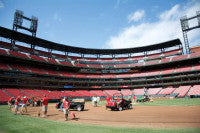
With our editorial team having converted sod to turf and soccer to football, Steve Bush, President of Bush Sports Turf explains how his team, with assistance from the stadium's ground crew and Chelsea's Head Groundsman, Jason Griffin, beat about the Busch!
I never imagined that, in my lifetime, I would have the privilege of doing the first 'soccer' pitch at Busch Stadium in St. Louis for a crowd of more than 48,000 fans. Yet, that is exactly what happened back in May.
Busch Stadium hosted two of the most famous teams in English Premier League football, Chelsea and Manchester City. It was a sellout crowd for the first non-baseball sporting events held at Busch Stadium since the venue opened in 2006. There were 48,263 fans in attendance, which is the largest crowd to ever attend a sporting event at the stadium.
Bush Sports Turf was chosen to collaborate with Busch Stadium head groundskeeper, Billy Findley, and vice president of stadium operations, Joe Abernathy, to convert the stadium from a baseball field to a football pitch - and then back to a baseball field - in a six day timeframe.
Our mission was to squeeze a 100m x 65m football pitch into Busch Stadium. It would require removing the pitcher's mound and infield clay, and turfing these areas, along with the four corners of the field, which would be on the warning track (see inset), and then quickly turning the pitch back to a baseball field.
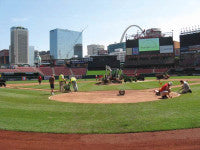
Without any extra time to work with, it was critical that the dirt not get saturated. With 48,000 fans attending the Thursday game, the field simply had to be ready.
To throw us a curveball, the organisers added an exhibition practice session to Wednesday night, meaning the field would essentially need to be done a day earlier that the original plan called for.
Pre-match
We had been planning this conversion for months, and had decided to use thickcut, 1.25 inch, sand-based turf from Heath Sod Farm in Wisconsin. We chose Heath, in part, because they were a regional supplier, which would save time and cost related to transportation. We also wanted a turf similar in colour and density to the rest of the field, and that was grown on a sand-based rootzone. We were concerned that using a native-soil turf could give us problems if it rained.
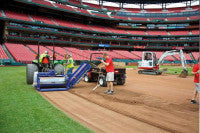
Our crew moved in first thing Monday morning and started removing the infield dirt. Billy and I were determined to provide a smooth playing surface without any noticeable transitions. We decided to take 1.25 inches of infield material off in order to match the thickness of the turf. This would allow for an easier installation and a level finished surface.
To do this, we used a Koro Field TopMaker 1200 with the new Terraplane Rotor, which is similar to a wood planer: it has cutting blades that leave a clean, even surface. This is one of the first two machines in the US to have this rotor.
The machine arrived from Holland a week before the project. It's actually the same machine used to level the clay courts at Wimbledon.
We mounted a laser receiver on the machine so we could monitor the depth of the cut and make sure we removed the exact amount of clay.
The clay was hauled out of the stadium using a fleet of Toro Workmans. We removed less material in the middle of the infield skin, creating a slight crown in order to help any excess water that hit move toward the edges of the field and into the rootzone. The baselines were then cut and removed using a sod cutter set at 1.25 inches.
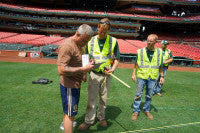
"This isn't new to us," he said of playing football in baseball stadiums. "But the process that they're using out here is a new way of doing it. It's very good. It is going to be nice and flat, which is what both teams want."
The pitcher's mound, which had been in place since the field was built in 2006, was being removed at the same time as the infield. It took the power of an excavator to get the tightly packed clay broken up so the mound could be hauled out. Like the baselines, the mound area was taken down 1.25 inches below grade as well.
The mound clay was kept in one pile, and the infield clay in another. Both piles were watered to try and keep the clays hydrated. We did not want them to get too dry, as this would make it hard to get them compacted and firm when we reapplied them to the field.
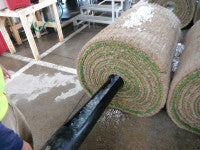
By the end of the first day, we had all of the clay removed and had installed turf at home plate, the baselines and the pitcher's mound. The 1.25-inch thick turf lined up perfectly with the existing grass. The 6mm plastic was installed under all of the turf, and the seams were sealed with tape. We had to make sure the clay beneath the turf did not get wet, as this might make the areas unstable, and make it difficult to reassemble the field after the game.
With heavy rain predicted, we covered the entire infield with tarpauline at the end of the day. Everything was going smoothly, and we were on schedule.
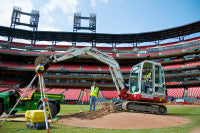
That night, severe thunderstorms tore through the St. Louis area. I was awake in the middle of the night, listening to the thunder and watching as it poured outside. I was glued to the weather radar on my iPad while the storm dumped 1.5 inches of rain on the field.
At that point, I wasn't terribly concerned, since we had covered the field with the tarpauline. But, when we showed up Tuesday morning, the situation was a little damper than my outlook. The strong winds that accompanied the storm had ripped the tarpauline, and the first base side of the skin was full of water.
Without wasting a minute, the Cardinals' grounds crew started doing everything they could to get rid of the water and wet clay. They used pumps, squeegees, rakes, brooms, shovels and conditioner. Some of the clay had to be completely removed, as it was totally saturated, and we did not have time to wait for it to dry.
Si 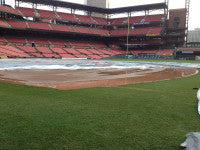
By afternoon, the first base side had dried enough that it could be graded and turfed as well. To ensure tight, unnoticeable seams, the thick-cut turf was pushed into place using our Sod Slider. The slider is a hydraulic, tractor-mounted device that pushes or pulls turf into position. We developed the slider in 2011 when we were installing more than six acres of turf at Halas Hall for the Chicago Bears.
Tight seams are critical, especially in football, as a bad seam can have a dramatic impact on the ball roll. The turf was rolled with a two-tonne vibratory roller, and we
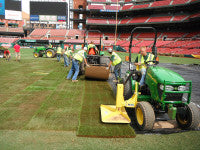
Once the infield was completed, the entire field was mown and turf paint applied to help blend the old turf with the new. They were nearly identical in color, but some of the new turf was stressed and had yellowed very slightly. Normally, it would grow out, but we only had one day to work with.
All of the newly installed turf was hand-watered, so as not to get too much water on top of the plastic. Once the paint dried, the infield was covered with the tarpauline for the night.
First thing Wednesday morning, we turfed the corners on the warning track. We left this until very last to avoid cutting off access to the field. Once the corners were installed, the field literally extended from wall-to-wall.

The field was mown to establish the pattern and the signature arch. Shortly after noon, the field still needed to be striped. It was a group effort to get this done. Bill and his crew, our crew and Jason from Chelsea set up the string lines around the perimeter of the field.
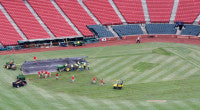
More than 10,000 fans attended the practice game that night.
Despite all of the cutting and turning during the practice, the turf stayed in place and played remarkably well. The practice was as much (if not more of) a test of the field's endurance as the main game would be, as the drills concentrated the activity in the areas we had turfed. But the field withstood it all, and the night ended with the turf unscathed.
And the next day, soccer left its mark on Busch Stadium ...

Goals from Javi Garcia, an Edin Dzeko brace and a last minute Micah Richards winner cancelled out earlier strikes from Ba, Azpilicueta and Oscar in a feast of attacking football.
It was a deserved win on the balance of play, on a night when the 48,263 fans present were treated to a first-class exhibition from two of the Premier League's most exciting outfits.
Back to baseball
Friday morning, we started the whole process in reverse as we began literally "throwing out" the pitch. The beautiful, thickcut turf was quickly removed, hauled out of the stadium, loaded on tractor trailers and hauled off-site to be composted. The plastic had done a nice job of keeping the clay dry under the turf, as well as keeping it clean.
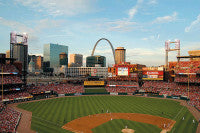
Then the base lines and home plate circle were filled in and levelled off. A form was set for the mound plateau, and the old clay was brought up in lifts and compacted around it. The mound was finished off with new clay on the plateau in the landing area.
By the middle of the Saturday, the field was put back together, and the warning track was cleaned up and ready for baseball.
It was an intense week, but an unmatchable experience. Working with world class groundkeepers in Billy Findley and Jason Griffin was an incredible honour, and building the first world-class football pitch at Busch Stadium is a project I will always remember with great pride. It was hard work, and had its challenges but, someday, I'll be telling my grandchildren I got to do the first football pitch at Busch Stadium, and that is priceless.
Steve Bush, CSFM, CFB (Certified Field Builder) is an agronomist and President of Bush Sports Turf
This article first appeared in SportsTurf (Sports Field and Facilities Management) www.sportsturfonline.com and is reprinted here by kind permission of their editor, Eric Schroder

Over the course of three days, the Blues revealed their new Nike kit, dropped in on the New York Giants, visited Lexington Academy and ferried over to Staten Island to donate equipment to a junior team hit by last year's Hurricane Sandy. All that and the small matter of helping launch the 20th MLS franchise, New York City FC on Tuesday morning.
City jetted into St Louis on Thursday morning to take on Chelsea in a match which sold out in just twenty minutes.
It had been announced in the build-up to kick-off at the iconic home of the St Louis Cardinals that City and Chelsea had donated $45k from ticket sales to victims of the devastating tornado in Oklahoma.
Players from both sides wore black armbands to pay tribute to the twenty-four victims of the catastrophic three-day storm and also took a moment of remembrance before kick-off dedicated to Drummer Lee Rigby who was so tragically killed in London.
With many of the big names playing, including Sergio Aguero, Yaya Toure, Carlos Tevez, Vincent Kompany, Dzeko and David Silva for City, and Demba Ba, Juan Mata, Fernando Torres, Oscar and David Luiz for Chelsea, the match was a fitting showcase for the Premier League's talents, with Manchester City running out 4-3 winners.
The two teams met again at the Yankee Stadium back in the Big Apple on Saturday night, before returning home for the summer break.
